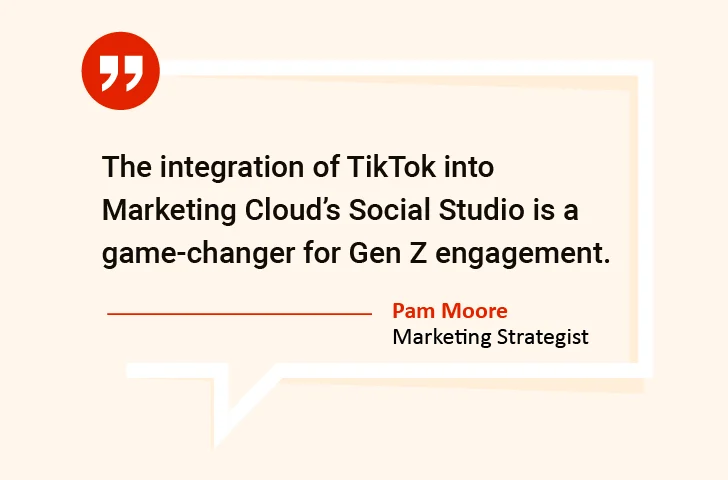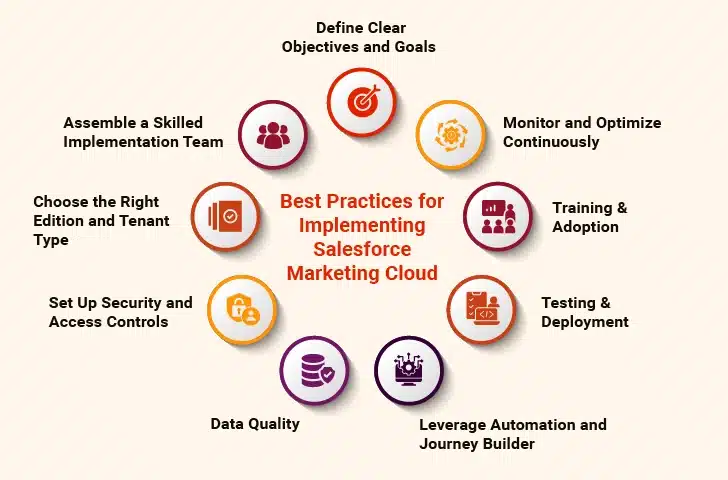A modern customer is always on the lookout for new information from businesses and prefers interacting with brands via new channels. In the digitally driven world of today, it is important for marketers to discover interesting ways to provide relevant content to their customers and connect with clients at the right time, through the right channel. This is easily made possible with Salesforce Marketing Cloud.
But what is Salesforce Marketing Cloud? It is a reliable platform for digital marketing that helps optimize marketing efforts and personalize the customer experience. You can easily customize emails, devise a comprehensive view of your customers, use AI-powered customized approaches, and manage B2B or B2C relationships. The platform allows you to connect all customer interactions and experiences with your Salesforce instance across various channels. You can easily react to the actions of your customers, control messaging flows, and unravel important insights to improve your business.
Marketing Cloud implementation provides you access to valuable statistical data that helps you analyze customer behavior and engagement levels and boost your marketing strategy. You can also join the Trailblazer community and connect with the partners, employees, and customers of Salesforce to discuss the tips and tricks for improving the performance of your Marketing Cloud. Now, let’s explore this detailed post that covers the benefits of Marketing Cloud and how it helps overcome business challenges. The post also delves into the core capabilities and best practices for Marketing Cloud implementation.
Table of Contents
Getting Started with Salesforce Marketing Cloud: The Marketer’s Playbook
Advantages of Salesforce Marketing Cloud
- I. Multichannel Marketing
- II. Customized Marketing Campaigns
- III. Flexibility and Scalability
- IV. Automation and Productivity
- 1. Better Marketing Strategies
- 2. Improved Customer Engagement
- 3. Efficient Sales Processes
- 4. Automated Marketing Campaigns and Processes
- 5. Better Insights into Marketing Performance
Core Capabilities of Salesforce Marketing Cloud
- I. Email Studio
- II. Journey Builder
- III. Mobile Studio
- IV. Social Studio
- V. Automation Studio
- VI. Content Builder
- VII. Data Management & Analytics
Best Practices for Implementing Salesforce Marketing Cloud
- 1. Define Clear Objectives and Goals
- 2. Assemble a Skilled Implementation Team
- 3. Choose the Right Edition and Tenant Type
- 4. Set Up Security and Access Controls
- 5. Data Quality
- 6. Leverage Automation and Journey Builder
- 7. Testing & Deployment
- 8. Training & Adotion
- 9. Monitor and Optimize Continuously
Advantages of Salesforce Marketing Cloud
Marketing Cloud is an AI-powered platform that can bring quality results to your business. Here are some important advantages of Marketing Cloud that you should know:
I. Multichannel Marketing
Salesforce Marketing Cloud helps businesses in reaching their customers across various channels, including social media, web, email, and mobile. Also, marketing cloud integrations boost the engagement and reach of customers. Important features that enable multichannel marketing include the following:
- Mobile Messaging: It allows users to send personalized and targeted messages to their customers via push notifications or SMS.
- Campaign Orchestration: With the help of this feature, you can orchestrate campaigns across different channels, ensuring a consistent experience and message.
- Social Media Advertising: This allows you to target customers on platforms like Twitter, LinkedIn, and Facebook.
Let Our Experts Help You Drive More Revenue with Salesforce Marketing Cloud.
II. Customized Marketing Campaigns
These days, a majority of customers like to engage with messaging that is tailored to them. Thus, using a personal approach while you are interacting with your customers is pivotal. Marketing Cloud helps collect data from the analytics and create customized journeys to provide the best customer experiences.
Marketing Cloud allows businesses to create and deliver custom-made marketing campaigns that cater to the specific preferences and needs of each customer. This drives customer engagement, loyalty, and ROI. A study reveals that organizations see nearly 300% ROI with Salesforce Marketing Cloud. Important features that enable personalized marketing include the following:
- Dynamic Content: This allows you to create content depending on the preferences and behaviors of customers. The result is more engagement and conversions.
- Advanced Segmentation: This feature allows you to segment your audience depending on factors such as behavior, interests, and demographics. This way, you are able to deliver more relevant and targeted campaigns.
- AI-Powered Recommendations: AI helps deliver more relevant and customized offers, leading to better customer retention and more loyalty.
III. Flexibility and Scalability
Marketing Cloud is a flexible and scalable platform that grows and evolves with your business needs. Some important features that enable flexibility and scalability include the following:
- AppExchange: AppExchange offers a huge range of pre-built apps and integrations on Salesforce, allowing you to add the required functionalities to your instance.
- Customization: You can customize and extend your Marketing Cloud to meet your specific business needs.
- Scalability: You can handle huge volumes of users and data with the platform, making it suitable for both big and small businesses.
By enabling automated, customized, and multichannel marketing campaigns, you can improve customer relationships and drive business growth. Features of scalability, real-time reporting, and flexibility help marketers in evolving and adapting to meet the changing needs of the marketplace.
IV. Automation and Productivity
You can automate and streamline your marketing workflows with the help of Salesforce Marketing Cloud. This helps you reduce costs and save time. The important features that make way for efficiency and automation include the following:
- Journey Builder: Journey Builder helps you create automated journeys to guide customers through a range of touchpoints like mobile messages, social media ads, emails, etc.
- Real-Time Reporting: You receive real-time reporting on the performance of your campaigns, allowing you to optimize campaigns and form data-driven decisions.
- Lead Management: This allows you to manage and score leads, thereby enabling the prioritization of the most promising leads.
Unlock the Power of Salesforce Marketing Cloud
How Salesforce Marketing Cloud Helps Resolve Business Challenges
Salesforce Marketing Cloud is an extensive platform that assists businesses in overcoming multiple marketing challenges. Let’s understand the important ways in which the platform resolves business challenges:
1. Better Marketing Strategies
Businesses tend to face the challenge of developing and implementing marketing strategies that resonate well with their target audience. Salesforce Marketing Cloud provides businesses with data-driven insights to create customized and relevant marketing campaigns that are capable of driving positive results.
2. Improved Customer Engagement
The advanced capabilities of the Marketing Cloud help businesses engage with their customers better. You can create tailor-made experiences across different marketing channels and enable improved customer loyalty and satisfaction.
3. Efficient Sales Processes
Marketing Cloud provides an extensive view of customer data, which can be utilized for optimizing sales processes. You can use the platform for segmenting customers depending on their preferences and behavior. This allows your sales teams to improve their interactions and make way for positive sales outcomes.
4. Automated Marketing Campaigns and Processes
Startups and small businesses tend to face the issue of limited marketing resources. Salesforce Marketing Cloud helps businesses resolve this challenge by automating various marketing campaigns and processes. This helps save resources and time and deliver better results.
5. Better Insights into Marketing Performance
Businesses often face the challenge of limited insights into their marketing performance. This makes it tough for them to measure the efficacy of their campaigns. With the help of real-time data and analytics of the Salesforce Marketing Cloud, you can track your marketing performance and optimize your strategies accordingly.
Realize the Potential of Salesforce Marketing Cloud with SFMC Consultants
Core Capabilities of Salesforce Marketing Cloud
Salesforce Marketing Cloud comes with useful marketing tools. These core features help businesses communicate better with customers while saving time and improving results. Here’s what makes the platform useful for marketers.
I. Email Studio
Email Studio helps you create and send emails to customers in a simple way. It lets you design messages that look good on phones and computers. You can personalize messaging to make it more relevant. The tool closely tracks how many people open your emails and click links present inside. It also helps manage contact lists to ensure emails reach the right audience. You can schedule emails to send at the most appropriate time. The system automatically handles bounced emails and unsubscribes. Everything works together to make email campaigns more effective while following rules about sending messages.
II. Journey Builder
This feature maps out customer interactions across different channels over time. It automatically delivers the right message at the right moment based on what the customer does. You can create paths that guide people from their first contact through ongoing engagement. The system reacts when customers take certain actions, like making purchases or visiting websites. It coordinates emails, mobile messages, and other communications in one sequence. This helps provide a smooth experience instead of random messages. You can see how customers move through these journeys to improve them.
III. Mobile Studio
IV. Social Studio
Social Studio helps manage your company’s presence on social media platforms. It tracks what people say about your brand across different networks. You can schedule posts and analyze conversations in a single place. The tool helps discover key trends and customer sentiment. It makes engaging with customers on social media more organized and measurable. You can see which types of content perform best to improve strategy. The system helps coordinate responses between team members. This brings structure to social media activities while maintaining authentic interactions with your audience.
“The integration of TikTok into Marketing Cloud’s Social Studio is a game-changer for Gen Z engagement.” – Pam Moore, Marketing Strategist.
V. Advertising Studio
Advertising Studio helps manage digital ads across different platforms in one place. It connects your customer data with advertising campaigns to show relevant ads to the right people. You can segment audiences based on how customers interact with your business. The tool helps track which ads perform best and adjust spending accordingly. It works with major ad platforms out there to sync messages across channels. This makes ad campaigns more targeted and efficient while keeping everything organized. You can also see how ads contribute to overall marketing results.
VI. Automation Studio
This feature helps save time by handling recurring marketing tasks on its own. It can send emails, update customer records, or trigger messages based on schedules or actions. You can set up the rules once, and the system follows them consistently. It helps organize complex campaigns that involve multiple steps and timing. The tool reduces manual work while ensuring nothing gets missed. You can also check automated processes to ensure they run smoothly. This allows focusing on strategy while routine tasks happen reliably in the background.
VII. Content Builder
Content Builder stores and organizes all marketing materials in one central place. It keeps images, documents, and other files ready for use in campaigns. You can create versions of content for different audiences or channels. The tool helps teams collaborate on marketing materials without losing track of changes. It also ensures everyone uses the latest approved versions. This prevents duplication and keeps branding uniform across all channels. Furthermore, you can find and reuse content easily instead of recreating it.
VIII. Data Management & Analytics
This feature collects and organizes customer data from diverse sources. It helps understand what customers prefer and how they behave by bringing data together. You can create reports that show what’s working in your marketing efforts. The tool also helps spot hidden trends and opportunities in customer interactions. This turns raw information into insights that make communications more effective.
Mastering AI & Personalization With Salesforce Marketing Cloud
Best Practices for Implementing Salesforce Marketing Cloud
Want to make the most of Marketing Cloud? These essential practices guide you through implementation, helping your team avoid common mistakes and create better customer experiences from day one.
1. Define Clear Objectives and Goals
Begin by writing down what you want to accomplish with SFDC Marketing Cloud. Think about the specific problems you need to solve or improvements you want to make. Consider which marketing activities take too much time or don’t work well. Be clear about how you will measure success, whether it’s more sales, better customer engagement, or something else. This clarity helps guide all other decisions about implementation and usage. Without clear goals, it’s easy to get features you don’t need or miss important ones. Keep these objectives realistic based on what the platform can do. Share them with everyone involved so the implementation stays focused.
2. Assemble a Skilled Implementation Team
Put together professionals who understand both your business and Marketing Cloud. Include marketing staff who know about your campaigns and technical experts who can set up the system. Furthermore, good teamwork between IT and marketing makes the implementation of Marketing Cloud smoother. The right mix of people helps avoid mistakes and get better results faster. Everyone should understand their role in making the project successful.
3. Choose the Right Edition and Tenant Type
Look at the different versions of SFDC Marketing Cloud available and pick what fits your needs. Consider how many customers you have and what features you’ll really use. Think about whether you need separate spaces for different parts of your business. The choice affects cost and flexibility, so take time to understand options. What works for a small business might not suit a large company. Your selection should support both current needs and future growth. Getting this right prevents having to switch later, which can be difficult and expensive.
4. Set Up Security and Access Controls
Decide who needs access to SFDC Marketing Cloud and what they should be able to do. Create different permission levels for various team members. Marketing staff might need different access than IT support. Set rules to protect customer data and prevent mistakes. Good security makes the system useful while keeping it safe. Document who has access to what and review this regularly. Always remember that a proper setup in the beginning prevents problems later and helps everyone work efficiently. It also ensures you meet any data protection rules that apply to your business.
5. Data Quality
Effective marketing starts with clean, organized customer information. Marketing Cloud helps bring together data from different sources and validates its accuracy. It removes duplicates and fills in missing details where possible. The system connects with your other business tools to keep information flowing smoothly. This means all teams work with the same up-to-date customer details. Clean data helps send the right messages to the right people. Furthermore, regular checks maintain data quality over time.
6. Leverage Automation and Journey Builder
The platform can handle routine marketing tasks automatically, saving time and effort. You set up the rules once for things like welcome emails or birthday messages. Journey Builder maps out customer interactions across different channels over time. It sends the right message at the right moment based on what customers do. This creates smooth, personalized experiences instead of random communications. Automated processes run consistently without forgetting steps. You can also adjust journeys as you learn what works best. This combination helps deliver relevant messages while reducing manual work.
7. Testing & Deployment
Before launching campaigns, test how they will work. Check that emails display properly on different devices. Confirm automated journeys follow the correct paths. Verify that data flows correctly between systems. Start with small groups to spot issues before reaching all customers. Monitor early results closely to catch any problems. Document what works well for future reference. Careful testing prevents mistakes that could annoy customers or waste resources. Gradual deployment allows fixing issues before they affect everyone. This approach builds confidence in your marketing systems.
8. Training & Adoption
Educate your team on how to use SFDC Marketing Cloud effectively. Start with basic features before moving to advanced tools. Show how the platform makes their jobs easier. Provide ongoing support as people gain experience. Encourage sharing tips and successes between team members. Make sure everyone understands why using the system matters. Good training increases the value you get from the platform. When people feel comfortable with the tools, they use them more creatively. Furthermore, regular check-ins help maintain skills as new features get added. User adoption also improves when staff see real benefits in their daily work.
9. Monitor and Optimize Continuously
After setting up SFDC Marketing Cloud, keep checking how well it works. Look at reports to see which campaigns perform best. Notice what times and messages get better responses. Watch for any technical issues that might need fixing. Make small improvements regularly instead of big changes rarely. Test different approaches to learn what customers prefer. Adjust your strategies based on what the data shows. This ongoing improvement helps get better results over time. Regular reviews catch problems before they grow. Overall, continuous optimization makes marketing more effective as you learn.
Summing Up
Salesforce Marketing Cloud provides businesses with tools to connect with customers in a smart and personal way. It makes marketing easier by letting companies send the right message to the right people. Whether it’s emails, social media, or ads, the tool helps businesses grow by building strong relationships with their audience.
The best part? You don’t need to be a tech expert to use it. With simple features and useful insights, even SMBs can make the most of it. If used well, Marketing Cloud can change the way businesses reach out to people, making every interaction meaningful.
Case in Focus

Japanese Manufacturer Achieved Shorter Sales Cycle and Maximized Deal Size Through Implementation of Salesforce Sales Cloud and CPQ








